Business Law Case Study Analysis: Max and Luke - BUS2010, Part 2
VerifiedAdded on 2023/01/11
|8
|2095
|87
Case Study
AI Summary
This case study delves into a complex business law scenario involving Max and Luke, who, after leaving Tri-City Landscapers Limited, establish a competing business, Three City Landscapers. The analysis examines various legal issues, including torts such as passing off, interference with contractual relations, defamation, and injurious falsehood. It also addresses restrictive covenants, trespass, and breach of contract. The case explores the legal ramifications of Max and Luke's actions, such as soliciting former clients, using a similar business name, and violating non-competition clauses. The document analyzes the legal claims of Tri-City Landscapers against Max and Luke, considering the elements of each tort and potential remedies like damages and injunctions. Furthermore, the case study evaluates the legality of restrictive covenants and the consequences of trespassing and breach of employment contracts, providing a comprehensive overview of the legal challenges faced by the parties involved.
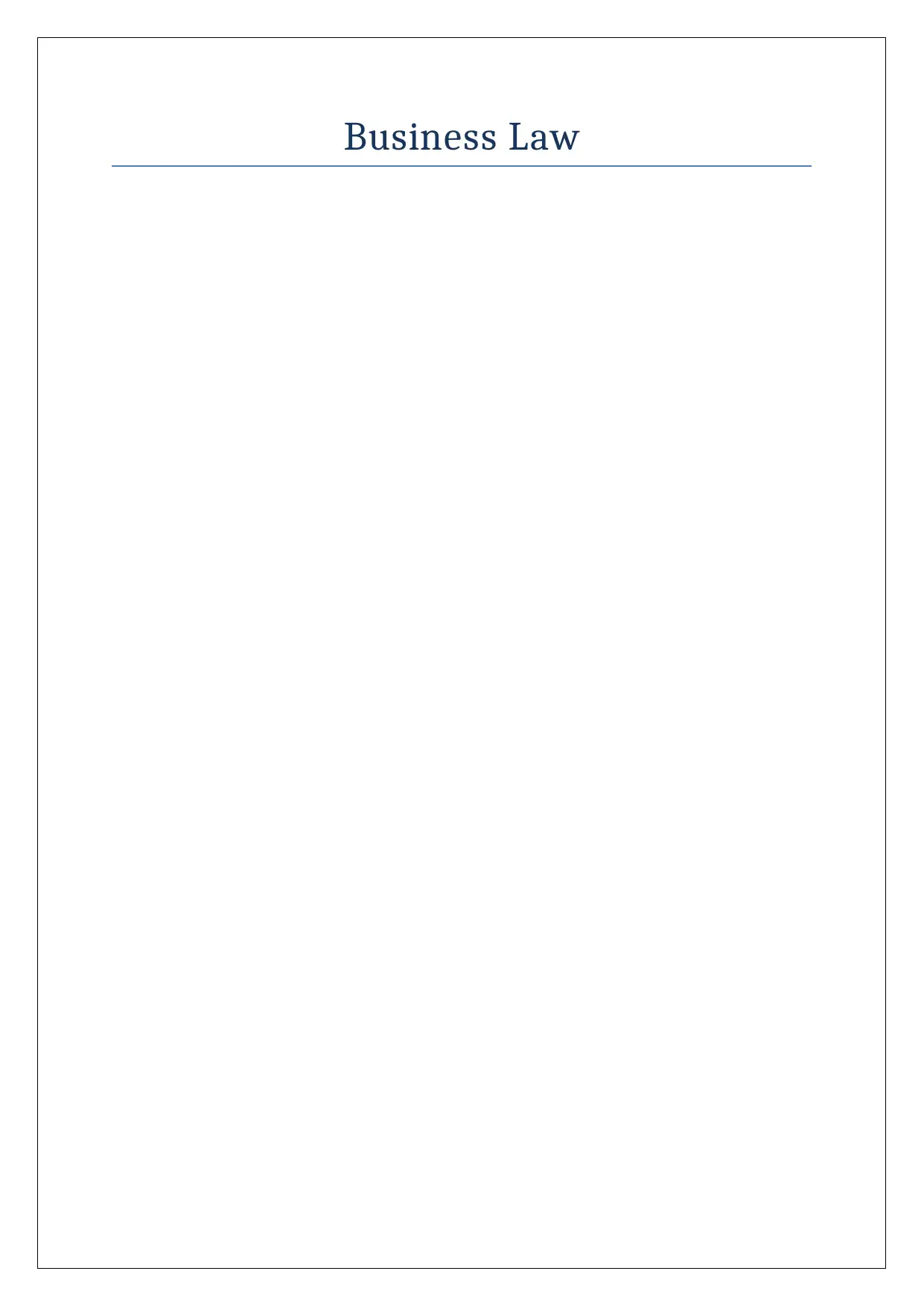
Business Law
Paraphrase This Document
Need a fresh take? Get an instant paraphrase of this document with our AI Paraphraser
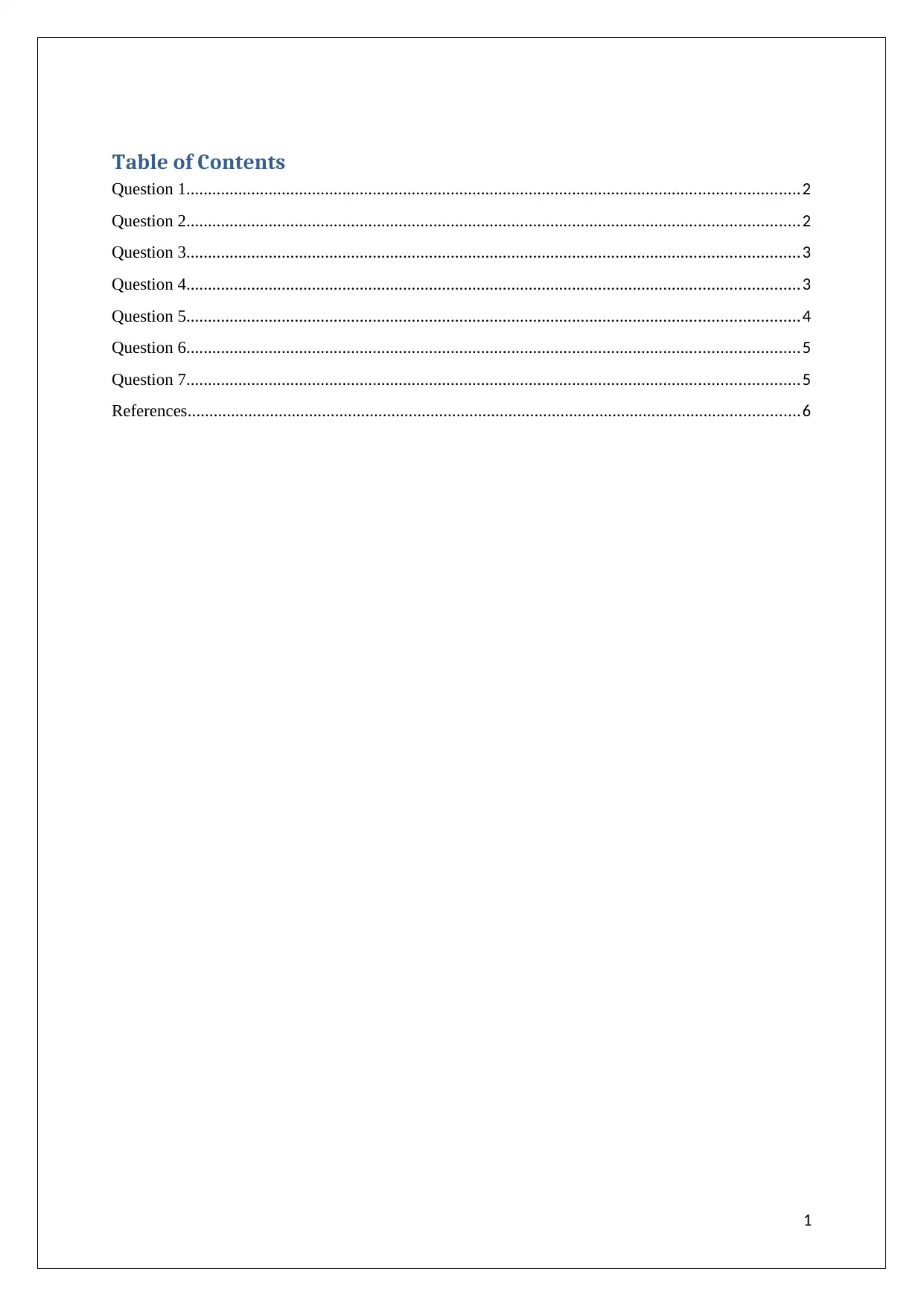
Table of Contents
Question 1.............................................................................................................................................2
Question 2.............................................................................................................................................2
Question 3.............................................................................................................................................3
Question 4.............................................................................................................................................3
Question 5.............................................................................................................................................4
Question 6.............................................................................................................................................5
Question 7.............................................................................................................................................5
References.............................................................................................................................................6
1
Question 1.............................................................................................................................................2
Question 2.............................................................................................................................................2
Question 3.............................................................................................................................................3
Question 4.............................................................................................................................................3
Question 5.............................................................................................................................................4
Question 6.............................................................................................................................................5
Question 7.............................................................................................................................................5
References.............................................................................................................................................6
1
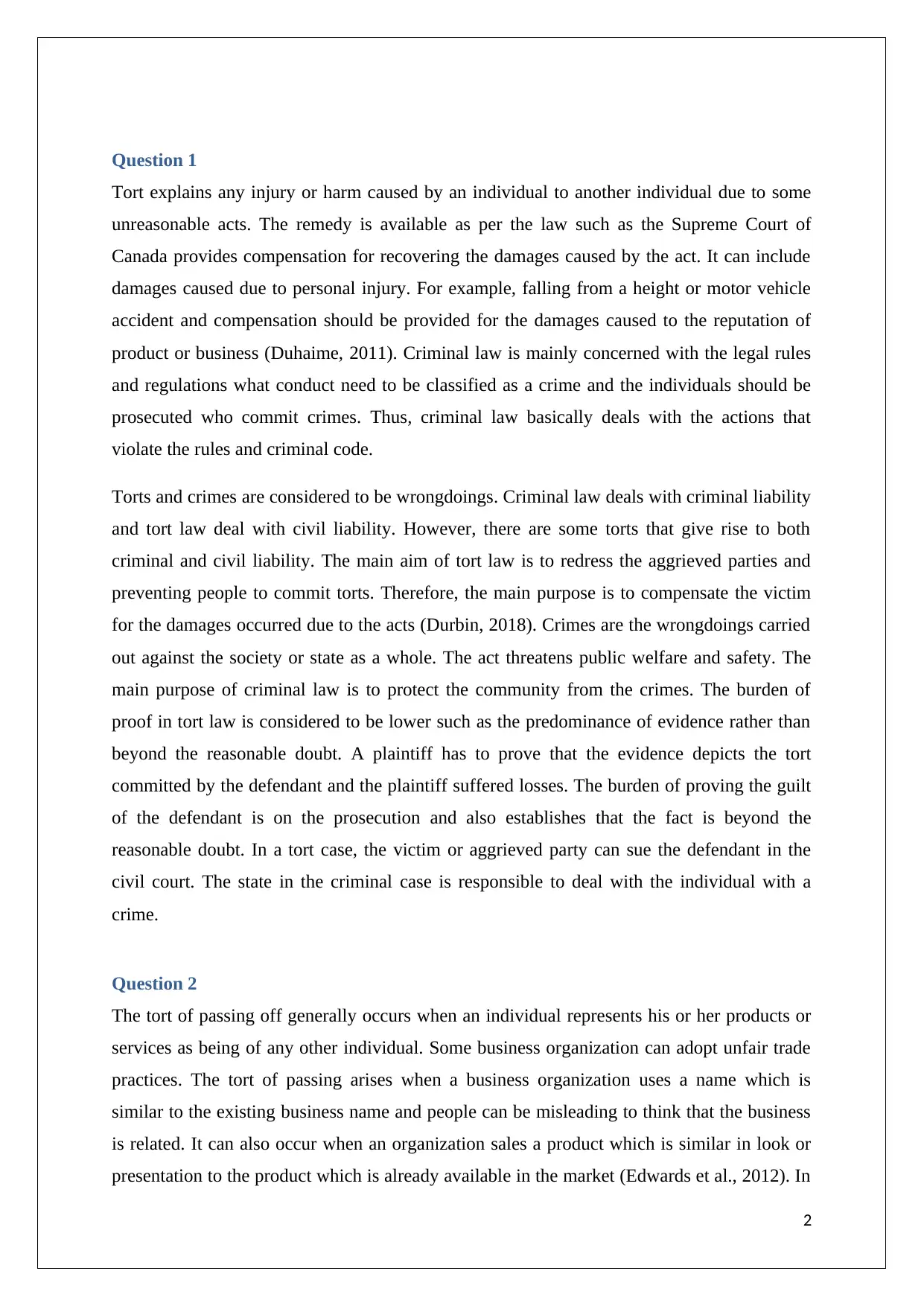
Question 1
Tort explains any injury or harm caused by an individual to another individual due to some
unreasonable acts. The remedy is available as per the law such as the Supreme Court of
Canada provides compensation for recovering the damages caused by the act. It can include
damages caused due to personal injury. For example, falling from a height or motor vehicle
accident and compensation should be provided for the damages caused to the reputation of
product or business (Duhaime, 2011). Criminal law is mainly concerned with the legal rules
and regulations what conduct need to be classified as a crime and the individuals should be
prosecuted who commit crimes. Thus, criminal law basically deals with the actions that
violate the rules and criminal code.
Torts and crimes are considered to be wrongdoings. Criminal law deals with criminal liability
and tort law deal with civil liability. However, there are some torts that give rise to both
criminal and civil liability. The main aim of tort law is to redress the aggrieved parties and
preventing people to commit torts. Therefore, the main purpose is to compensate the victim
for the damages occurred due to the acts (Durbin, 2018). Crimes are the wrongdoings carried
out against the society or state as a whole. The act threatens public welfare and safety. The
main purpose of criminal law is to protect the community from the crimes. The burden of
proof in tort law is considered to be lower such as the predominance of evidence rather than
beyond the reasonable doubt. A plaintiff has to prove that the evidence depicts the tort
committed by the defendant and the plaintiff suffered losses. The burden of proving the guilt
of the defendant is on the prosecution and also establishes that the fact is beyond the
reasonable doubt. In a tort case, the victim or aggrieved party can sue the defendant in the
civil court. The state in the criminal case is responsible to deal with the individual with a
crime.
Question 2
The tort of passing off generally occurs when an individual represents his or her products or
services as being of any other individual. Some business organization can adopt unfair trade
practices. The tort of passing arises when a business organization uses a name which is
similar to the existing business name and people can be misleading to think that the business
is related. It can also occur when an organization sales a product which is similar in look or
presentation to the product which is already available in the market (Edwards et al., 2012). In
2
Tort explains any injury or harm caused by an individual to another individual due to some
unreasonable acts. The remedy is available as per the law such as the Supreme Court of
Canada provides compensation for recovering the damages caused by the act. It can include
damages caused due to personal injury. For example, falling from a height or motor vehicle
accident and compensation should be provided for the damages caused to the reputation of
product or business (Duhaime, 2011). Criminal law is mainly concerned with the legal rules
and regulations what conduct need to be classified as a crime and the individuals should be
prosecuted who commit crimes. Thus, criminal law basically deals with the actions that
violate the rules and criminal code.
Torts and crimes are considered to be wrongdoings. Criminal law deals with criminal liability
and tort law deal with civil liability. However, there are some torts that give rise to both
criminal and civil liability. The main aim of tort law is to redress the aggrieved parties and
preventing people to commit torts. Therefore, the main purpose is to compensate the victim
for the damages occurred due to the acts (Durbin, 2018). Crimes are the wrongdoings carried
out against the society or state as a whole. The act threatens public welfare and safety. The
main purpose of criminal law is to protect the community from the crimes. The burden of
proof in tort law is considered to be lower such as the predominance of evidence rather than
beyond the reasonable doubt. A plaintiff has to prove that the evidence depicts the tort
committed by the defendant and the plaintiff suffered losses. The burden of proving the guilt
of the defendant is on the prosecution and also establishes that the fact is beyond the
reasonable doubt. In a tort case, the victim or aggrieved party can sue the defendant in the
civil court. The state in the criminal case is responsible to deal with the individual with a
crime.
Question 2
The tort of passing off generally occurs when an individual represents his or her products or
services as being of any other individual. Some business organization can adopt unfair trade
practices. The tort of passing arises when a business organization uses a name which is
similar to the existing business name and people can be misleading to think that the business
is related. It can also occur when an organization sales a product which is similar in look or
presentation to the product which is already available in the market (Edwards et al., 2012). In
2
⊘ This is a preview!⊘
Do you want full access?
Subscribe today to unlock all pages.

Trusted by 1+ million students worldwide
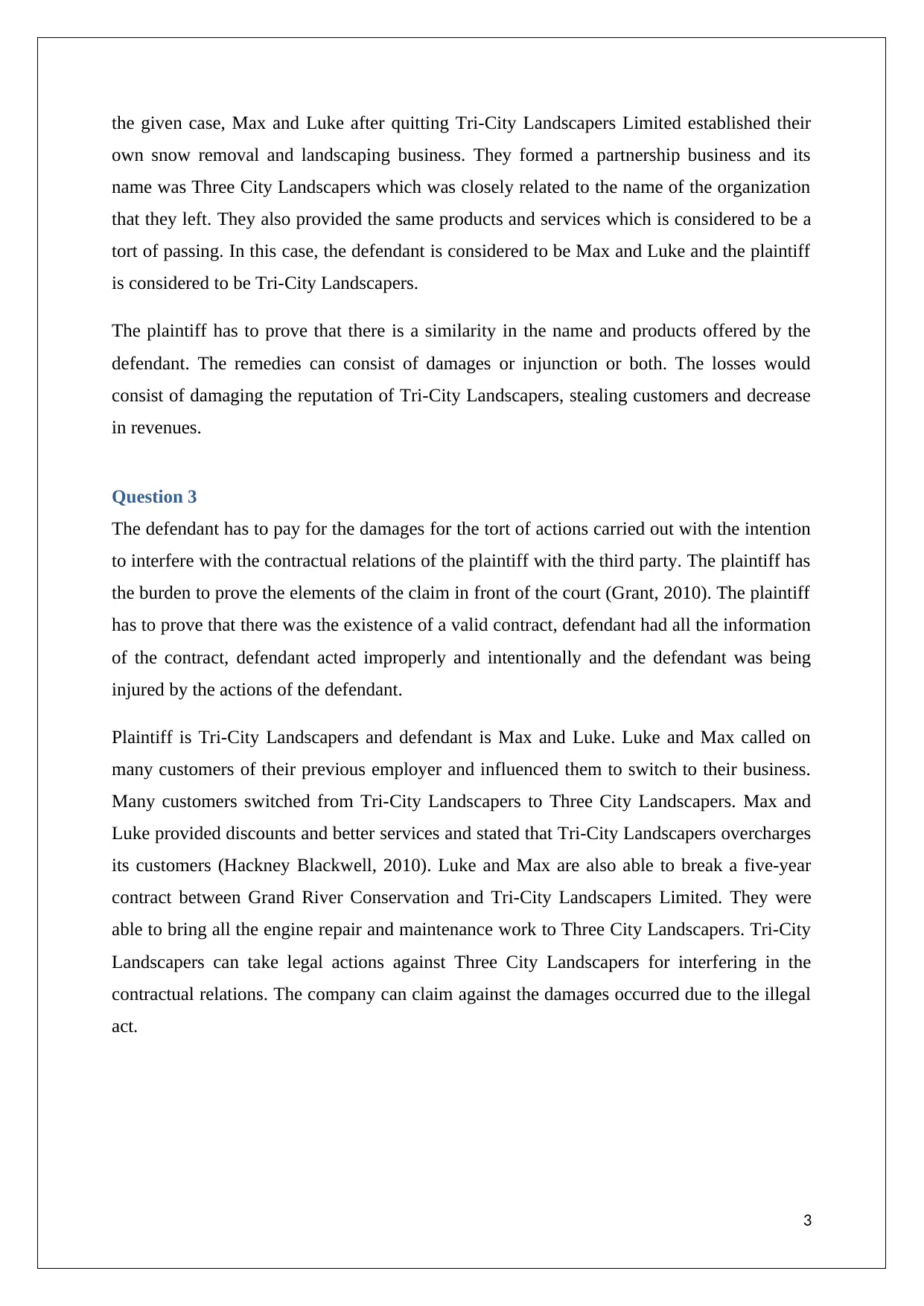
the given case, Max and Luke after quitting Tri-City Landscapers Limited established their
own snow removal and landscaping business. They formed a partnership business and its
name was Three City Landscapers which was closely related to the name of the organization
that they left. They also provided the same products and services which is considered to be a
tort of passing. In this case, the defendant is considered to be Max and Luke and the plaintiff
is considered to be Tri-City Landscapers.
The plaintiff has to prove that there is a similarity in the name and products offered by the
defendant. The remedies can consist of damages or injunction or both. The losses would
consist of damaging the reputation of Tri-City Landscapers, stealing customers and decrease
in revenues.
Question 3
The defendant has to pay for the damages for the tort of actions carried out with the intention
to interfere with the contractual relations of the plaintiff with the third party. The plaintiff has
the burden to prove the elements of the claim in front of the court (Grant, 2010). The plaintiff
has to prove that there was the existence of a valid contract, defendant had all the information
of the contract, defendant acted improperly and intentionally and the defendant was being
injured by the actions of the defendant.
Plaintiff is Tri-City Landscapers and defendant is Max and Luke. Luke and Max called on
many customers of their previous employer and influenced them to switch to their business.
Many customers switched from Tri-City Landscapers to Three City Landscapers. Max and
Luke provided discounts and better services and stated that Tri-City Landscapers overcharges
its customers (Hackney Blackwell, 2010). Luke and Max are also able to break a five-year
contract between Grand River Conservation and Tri-City Landscapers Limited. They were
able to bring all the engine repair and maintenance work to Three City Landscapers. Tri-City
Landscapers can take legal actions against Three City Landscapers for interfering in the
contractual relations. The company can claim against the damages occurred due to the illegal
act.
3
own snow removal and landscaping business. They formed a partnership business and its
name was Three City Landscapers which was closely related to the name of the organization
that they left. They also provided the same products and services which is considered to be a
tort of passing. In this case, the defendant is considered to be Max and Luke and the plaintiff
is considered to be Tri-City Landscapers.
The plaintiff has to prove that there is a similarity in the name and products offered by the
defendant. The remedies can consist of damages or injunction or both. The losses would
consist of damaging the reputation of Tri-City Landscapers, stealing customers and decrease
in revenues.
Question 3
The defendant has to pay for the damages for the tort of actions carried out with the intention
to interfere with the contractual relations of the plaintiff with the third party. The plaintiff has
the burden to prove the elements of the claim in front of the court (Grant, 2010). The plaintiff
has to prove that there was the existence of a valid contract, defendant had all the information
of the contract, defendant acted improperly and intentionally and the defendant was being
injured by the actions of the defendant.
Plaintiff is Tri-City Landscapers and defendant is Max and Luke. Luke and Max called on
many customers of their previous employer and influenced them to switch to their business.
Many customers switched from Tri-City Landscapers to Three City Landscapers. Max and
Luke provided discounts and better services and stated that Tri-City Landscapers overcharges
its customers (Hackney Blackwell, 2010). Luke and Max are also able to break a five-year
contract between Grand River Conservation and Tri-City Landscapers Limited. They were
able to bring all the engine repair and maintenance work to Three City Landscapers. Tri-City
Landscapers can take legal actions against Three City Landscapers for interfering in the
contractual relations. The company can claim against the damages occurred due to the illegal
act.
3
Paraphrase This Document
Need a fresh take? Get an instant paraphrase of this document with our AI Paraphraser
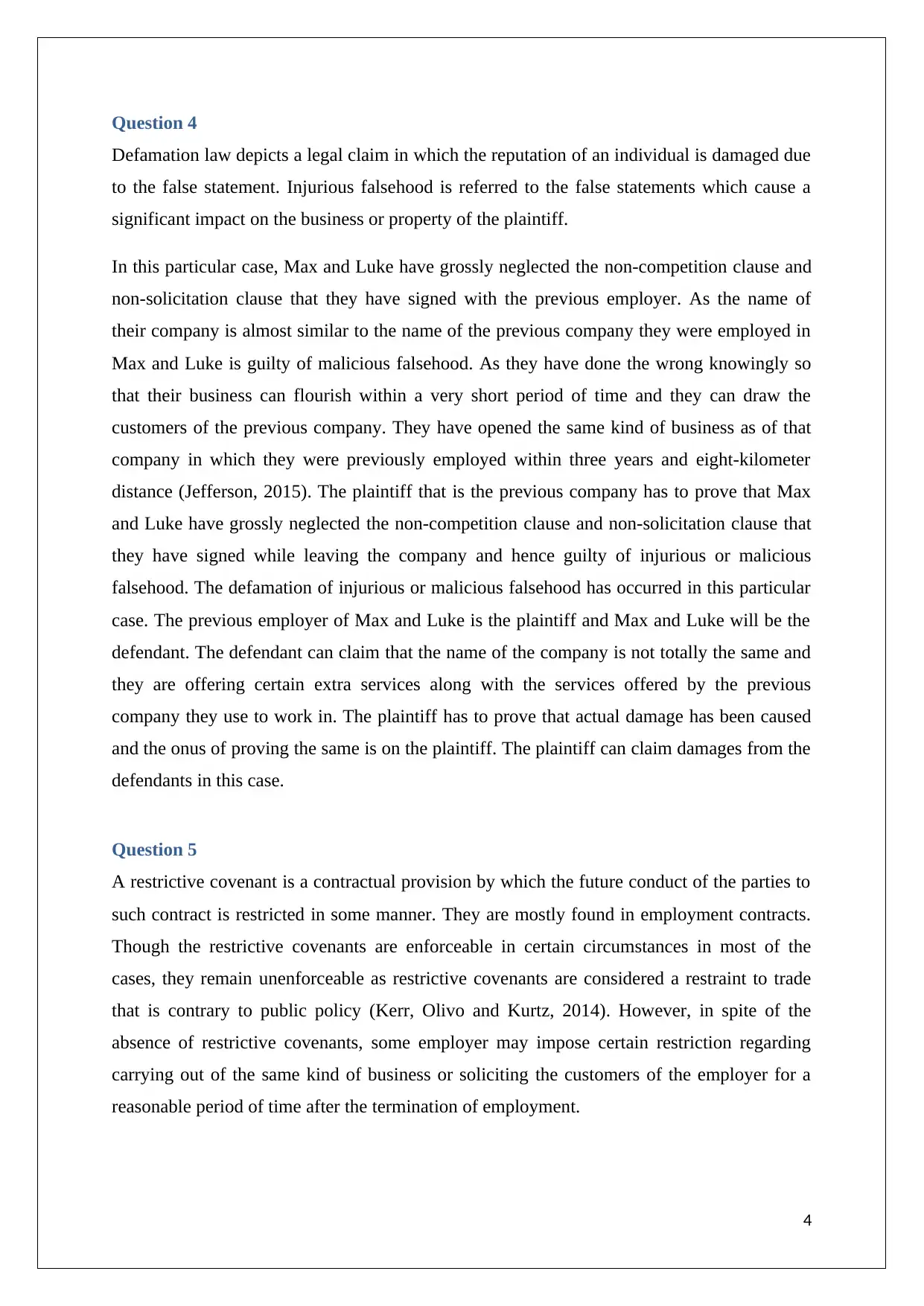
Question 4
Defamation law depicts a legal claim in which the reputation of an individual is damaged due
to the false statement. Injurious falsehood is referred to the false statements which cause a
significant impact on the business or property of the plaintiff.
In this particular case, Max and Luke have grossly neglected the non-competition clause and
non-solicitation clause that they have signed with the previous employer. As the name of
their company is almost similar to the name of the previous company they were employed in
Max and Luke is guilty of malicious falsehood. As they have done the wrong knowingly so
that their business can flourish within a very short period of time and they can draw the
customers of the previous company. They have opened the same kind of business as of that
company in which they were previously employed within three years and eight-kilometer
distance (Jefferson, 2015). The plaintiff that is the previous company has to prove that Max
and Luke have grossly neglected the non-competition clause and non-solicitation clause that
they have signed while leaving the company and hence guilty of injurious or malicious
falsehood. The defamation of injurious or malicious falsehood has occurred in this particular
case. The previous employer of Max and Luke is the plaintiff and Max and Luke will be the
defendant. The defendant can claim that the name of the company is not totally the same and
they are offering certain extra services along with the services offered by the previous
company they use to work in. The plaintiff has to prove that actual damage has been caused
and the onus of proving the same is on the plaintiff. The plaintiff can claim damages from the
defendants in this case.
Question 5
A restrictive covenant is a contractual provision by which the future conduct of the parties to
such contract is restricted in some manner. They are mostly found in employment contracts.
Though the restrictive covenants are enforceable in certain circumstances in most of the
cases, they remain unenforceable as restrictive covenants are considered a restraint to trade
that is contrary to public policy (Kerr, Olivo and Kurtz, 2014). However, in spite of the
absence of restrictive covenants, some employer may impose certain restriction regarding
carrying out of the same kind of business or soliciting the customers of the employer for a
reasonable period of time after the termination of employment.
4
Defamation law depicts a legal claim in which the reputation of an individual is damaged due
to the false statement. Injurious falsehood is referred to the false statements which cause a
significant impact on the business or property of the plaintiff.
In this particular case, Max and Luke have grossly neglected the non-competition clause and
non-solicitation clause that they have signed with the previous employer. As the name of
their company is almost similar to the name of the previous company they were employed in
Max and Luke is guilty of malicious falsehood. As they have done the wrong knowingly so
that their business can flourish within a very short period of time and they can draw the
customers of the previous company. They have opened the same kind of business as of that
company in which they were previously employed within three years and eight-kilometer
distance (Jefferson, 2015). The plaintiff that is the previous company has to prove that Max
and Luke have grossly neglected the non-competition clause and non-solicitation clause that
they have signed while leaving the company and hence guilty of injurious or malicious
falsehood. The defamation of injurious or malicious falsehood has occurred in this particular
case. The previous employer of Max and Luke is the plaintiff and Max and Luke will be the
defendant. The defendant can claim that the name of the company is not totally the same and
they are offering certain extra services along with the services offered by the previous
company they use to work in. The plaintiff has to prove that actual damage has been caused
and the onus of proving the same is on the plaintiff. The plaintiff can claim damages from the
defendants in this case.
Question 5
A restrictive covenant is a contractual provision by which the future conduct of the parties to
such contract is restricted in some manner. They are mostly found in employment contracts.
Though the restrictive covenants are enforceable in certain circumstances in most of the
cases, they remain unenforceable as restrictive covenants are considered a restraint to trade
that is contrary to public policy (Kerr, Olivo and Kurtz, 2014). However, in spite of the
absence of restrictive covenants, some employer may impose certain restriction regarding
carrying out of the same kind of business or soliciting the customers of the employer for a
reasonable period of time after the termination of employment.
4
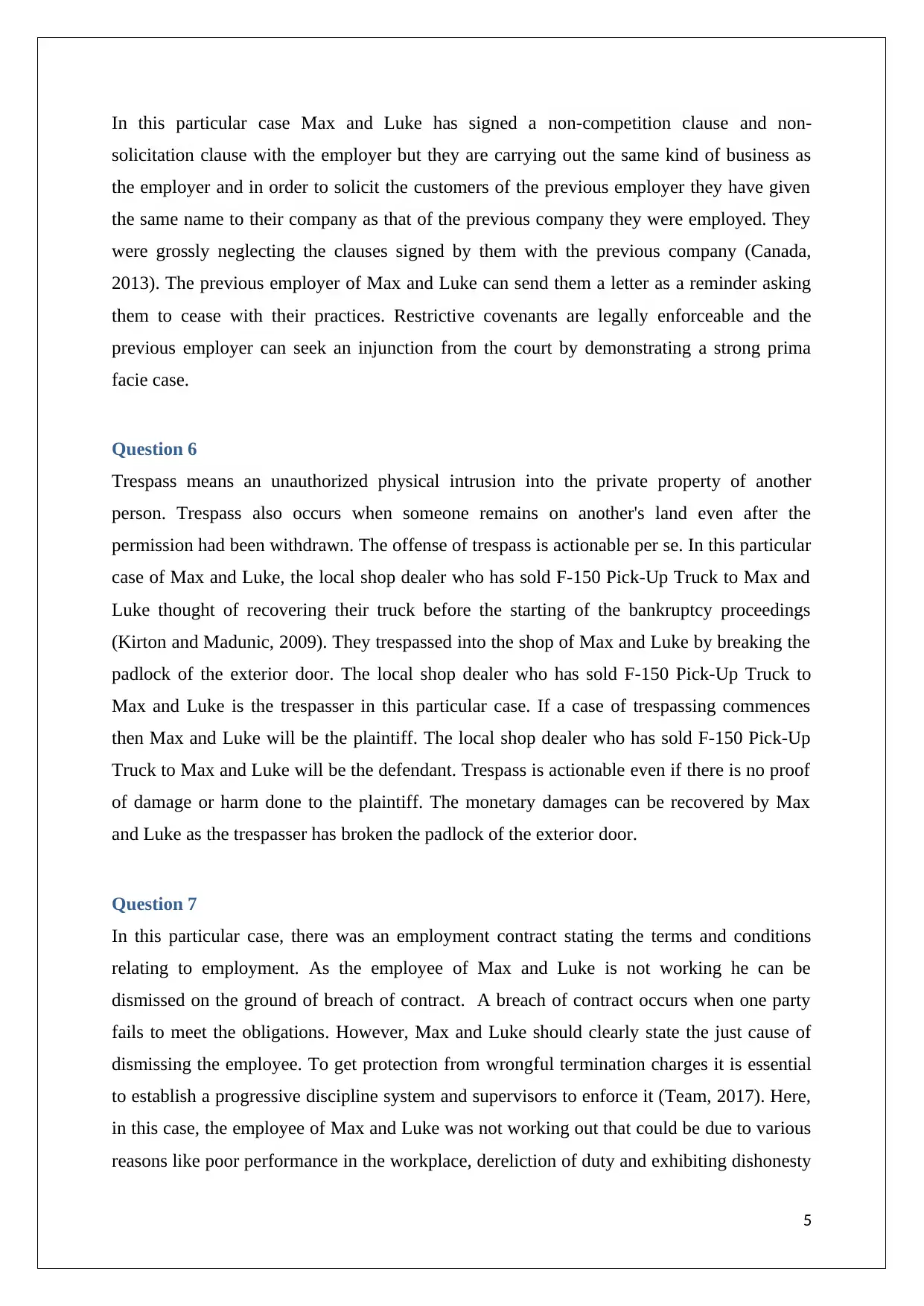
In this particular case Max and Luke has signed a non-competition clause and non-
solicitation clause with the employer but they are carrying out the same kind of business as
the employer and in order to solicit the customers of the previous employer they have given
the same name to their company as that of the previous company they were employed. They
were grossly neglecting the clauses signed by them with the previous company (Canada,
2013). The previous employer of Max and Luke can send them a letter as a reminder asking
them to cease with their practices. Restrictive covenants are legally enforceable and the
previous employer can seek an injunction from the court by demonstrating a strong prima
facie case.
Question 6
Trespass means an unauthorized physical intrusion into the private property of another
person. Trespass also occurs when someone remains on another's land even after the
permission had been withdrawn. The offense of trespass is actionable per se. In this particular
case of Max and Luke, the local shop dealer who has sold F-150 Pick-Up Truck to Max and
Luke thought of recovering their truck before the starting of the bankruptcy proceedings
(Kirton and Madunic, 2009). They trespassed into the shop of Max and Luke by breaking the
padlock of the exterior door. The local shop dealer who has sold F-150 Pick-Up Truck to
Max and Luke is the trespasser in this particular case. If a case of trespassing commences
then Max and Luke will be the plaintiff. The local shop dealer who has sold F-150 Pick-Up
Truck to Max and Luke will be the defendant. Trespass is actionable even if there is no proof
of damage or harm done to the plaintiff. The monetary damages can be recovered by Max
and Luke as the trespasser has broken the padlock of the exterior door.
Question 7
In this particular case, there was an employment contract stating the terms and conditions
relating to employment. As the employee of Max and Luke is not working he can be
dismissed on the ground of breach of contract. A breach of contract occurs when one party
fails to meet the obligations. However, Max and Luke should clearly state the just cause of
dismissing the employee. To get protection from wrongful termination charges it is essential
to establish a progressive discipline system and supervisors to enforce it (Team, 2017). Here,
in this case, the employee of Max and Luke was not working out that could be due to various
reasons like poor performance in the workplace, dereliction of duty and exhibiting dishonesty
5
solicitation clause with the employer but they are carrying out the same kind of business as
the employer and in order to solicit the customers of the previous employer they have given
the same name to their company as that of the previous company they were employed. They
were grossly neglecting the clauses signed by them with the previous company (Canada,
2013). The previous employer of Max and Luke can send them a letter as a reminder asking
them to cease with their practices. Restrictive covenants are legally enforceable and the
previous employer can seek an injunction from the court by demonstrating a strong prima
facie case.
Question 6
Trespass means an unauthorized physical intrusion into the private property of another
person. Trespass also occurs when someone remains on another's land even after the
permission had been withdrawn. The offense of trespass is actionable per se. In this particular
case of Max and Luke, the local shop dealer who has sold F-150 Pick-Up Truck to Max and
Luke thought of recovering their truck before the starting of the bankruptcy proceedings
(Kirton and Madunic, 2009). They trespassed into the shop of Max and Luke by breaking the
padlock of the exterior door. The local shop dealer who has sold F-150 Pick-Up Truck to
Max and Luke is the trespasser in this particular case. If a case of trespassing commences
then Max and Luke will be the plaintiff. The local shop dealer who has sold F-150 Pick-Up
Truck to Max and Luke will be the defendant. Trespass is actionable even if there is no proof
of damage or harm done to the plaintiff. The monetary damages can be recovered by Max
and Luke as the trespasser has broken the padlock of the exterior door.
Question 7
In this particular case, there was an employment contract stating the terms and conditions
relating to employment. As the employee of Max and Luke is not working he can be
dismissed on the ground of breach of contract. A breach of contract occurs when one party
fails to meet the obligations. However, Max and Luke should clearly state the just cause of
dismissing the employee. To get protection from wrongful termination charges it is essential
to establish a progressive discipline system and supervisors to enforce it (Team, 2017). Here,
in this case, the employee of Max and Luke was not working out that could be due to various
reasons like poor performance in the workplace, dereliction of duty and exhibiting dishonesty
5
⊘ This is a preview!⊘
Do you want full access?
Subscribe today to unlock all pages.

Trusted by 1+ million students worldwide
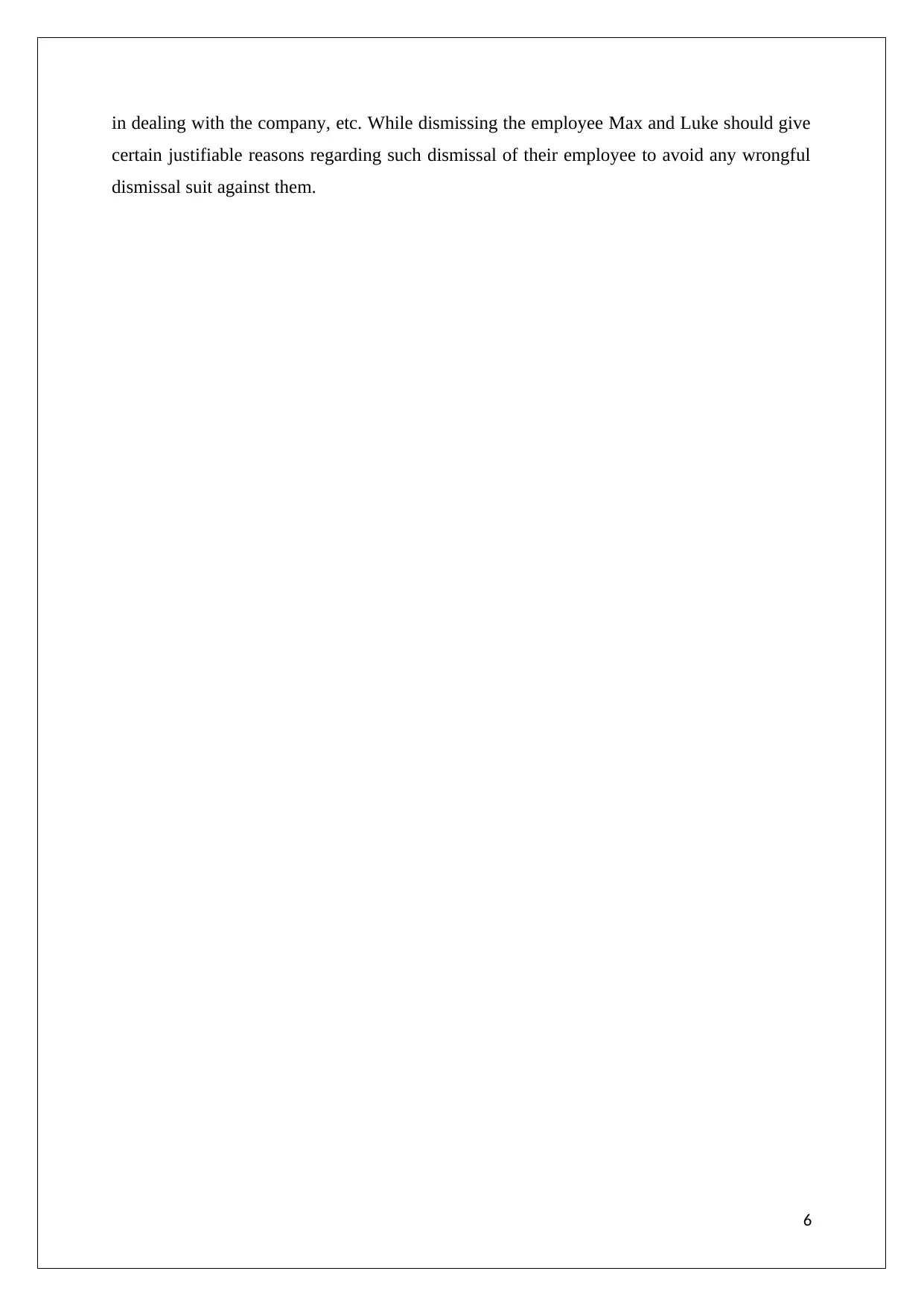
in dealing with the company, etc. While dismissing the employee Max and Luke should give
certain justifiable reasons regarding such dismissal of their employee to avoid any wrongful
dismissal suit against them.
6
certain justifiable reasons regarding such dismissal of their employee to avoid any wrongful
dismissal suit against them.
6
Paraphrase This Document
Need a fresh take? Get an instant paraphrase of this document with our AI Paraphraser
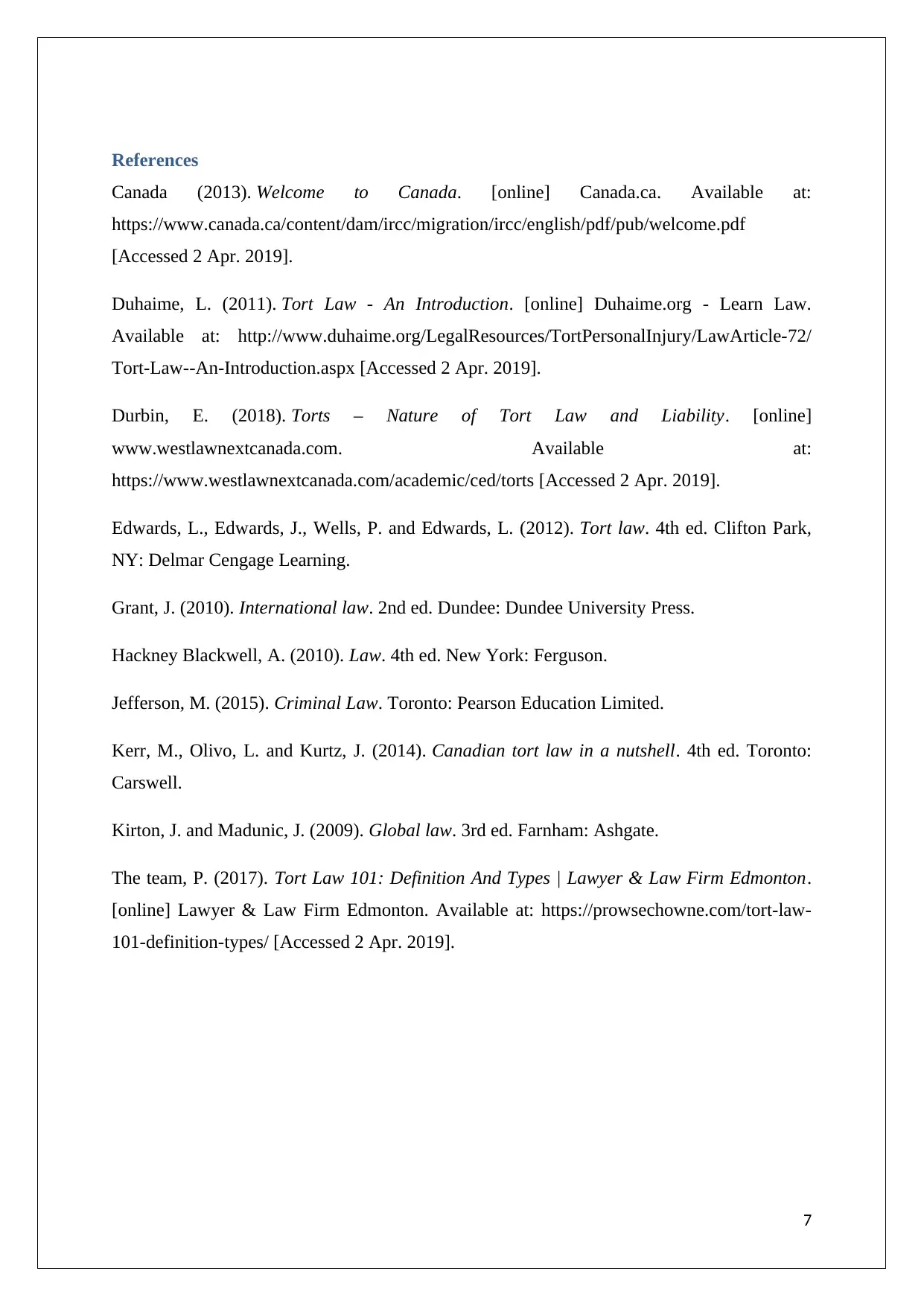
References
Canada (2013). Welcome to Canada. [online] Canada.ca. Available at:
https://www.canada.ca/content/dam/ircc/migration/ircc/english/pdf/pub/welcome.pdf
[Accessed 2 Apr. 2019].
Duhaime, L. (2011). Tort Law - An Introduction. [online] Duhaime.org - Learn Law.
Available at: http://www.duhaime.org/LegalResources/TortPersonalInjury/LawArticle-72/
Tort-Law--An-Introduction.aspx [Accessed 2 Apr. 2019].
Durbin, E. (2018). Torts – Nature of Tort Law and Liability. [online]
www.westlawnextcanada.com. Available at:
https://www.westlawnextcanada.com/academic/ced/torts [Accessed 2 Apr. 2019].
Edwards, L., Edwards, J., Wells, P. and Edwards, L. (2012). Tort law. 4th ed. Clifton Park,
NY: Delmar Cengage Learning.
Grant, J. (2010). International law. 2nd ed. Dundee: Dundee University Press.
Hackney Blackwell, A. (2010). Law. 4th ed. New York: Ferguson.
Jefferson, M. (2015). Criminal Law. Toronto: Pearson Education Limited.
Kerr, M., Olivo, L. and Kurtz, J. (2014). Canadian tort law in a nutshell. 4th ed. Toronto:
Carswell.
Kirton, J. and Madunic, J. (2009). Global law. 3rd ed. Farnham: Ashgate.
The team, P. (2017). Tort Law 101: Definition And Types | Lawyer & Law Firm Edmonton.
[online] Lawyer & Law Firm Edmonton. Available at: https://prowsechowne.com/tort-law-
101-definition-types/ [Accessed 2 Apr. 2019].
7
Canada (2013). Welcome to Canada. [online] Canada.ca. Available at:
https://www.canada.ca/content/dam/ircc/migration/ircc/english/pdf/pub/welcome.pdf
[Accessed 2 Apr. 2019].
Duhaime, L. (2011). Tort Law - An Introduction. [online] Duhaime.org - Learn Law.
Available at: http://www.duhaime.org/LegalResources/TortPersonalInjury/LawArticle-72/
Tort-Law--An-Introduction.aspx [Accessed 2 Apr. 2019].
Durbin, E. (2018). Torts – Nature of Tort Law and Liability. [online]
www.westlawnextcanada.com. Available at:
https://www.westlawnextcanada.com/academic/ced/torts [Accessed 2 Apr. 2019].
Edwards, L., Edwards, J., Wells, P. and Edwards, L. (2012). Tort law. 4th ed. Clifton Park,
NY: Delmar Cengage Learning.
Grant, J. (2010). International law. 2nd ed. Dundee: Dundee University Press.
Hackney Blackwell, A. (2010). Law. 4th ed. New York: Ferguson.
Jefferson, M. (2015). Criminal Law. Toronto: Pearson Education Limited.
Kerr, M., Olivo, L. and Kurtz, J. (2014). Canadian tort law in a nutshell. 4th ed. Toronto:
Carswell.
Kirton, J. and Madunic, J. (2009). Global law. 3rd ed. Farnham: Ashgate.
The team, P. (2017). Tort Law 101: Definition And Types | Lawyer & Law Firm Edmonton.
[online] Lawyer & Law Firm Edmonton. Available at: https://prowsechowne.com/tort-law-
101-definition-types/ [Accessed 2 Apr. 2019].
7
1 out of 8
Related Documents
Your All-in-One AI-Powered Toolkit for Academic Success.
+13062052269
info@desklib.com
Available 24*7 on WhatsApp / Email
![[object Object]](/_next/static/media/star-bottom.7253800d.svg)
Unlock your academic potential
Copyright © 2020–2025 A2Z Services. All Rights Reserved. Developed and managed by ZUCOL.





